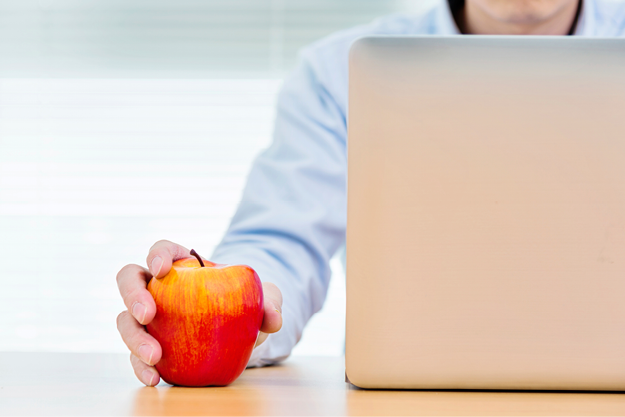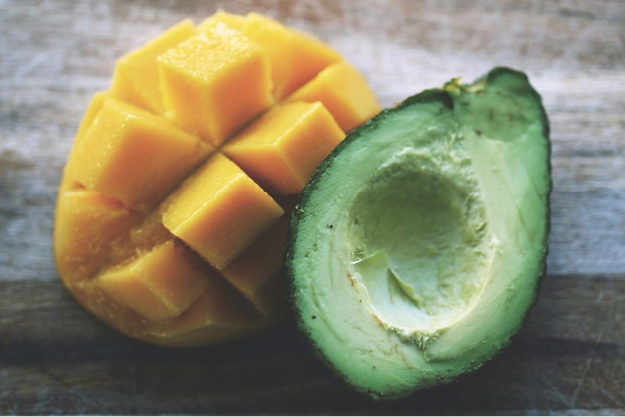
Make skillful food choices for energy throughout the workday.
- Eating mindfully
- Breakfast
- Snacking
- Packing lunches
- Dining out
- Beverages
- Downloadable version
- Dining options on your campus (coming soon!)
While you’re at work you can eat food that tastes good and energizes your body throughout the day. This toolkit provides information about how to eat healthy and make skillful food choices to eat well at work. In general, a well-balanced healthy meal includes fruits, vegetables, lean protein, and whole grains and is limited in foods high in solid fats, added sugars, and salt. Healthy meals should not be overly restrictive, leave you feeling hungry afterward, or be boring and bland. Healthy meals can be delicious!
Eating mindfully
One way to insure that you are eating well is to pay attention to the signals your body sends you about how hungry or full you are. Before and during your meals, assess how hungry or satisfied you are and eat the amount of food that helps you feel just right. You can use the basics of mindful eating below as a guide.

Try the BASICS of mindful eating:
- Breathe and belly check for hunger and satiety before you eat.
- Assess your food
- Slow down
- Investigate your hunger and satiety throughout the meal
- Chew your food thoroughly
- Savor your food
Stress and emotional eating
When you are stressed or experiencing difficult emotions, it is easy to use food as a way to make yourself feel better. This may cause you to eat when you are not truly hungry, eat more than you intended, or eat foods that are not healthy. When you are stressed, here are other ways to help you feel more relaxed and address the issues at hand.
Quick tips:
- Take a walk, stretch, or exercise instead of eating
- Use other relaxation techniques such as deep breathing, yoga, or meditation
- Talk to a friend or co-worker about your situation
Food as a reward
Oftentimes food is used to celebrate accomplishments or to reward a team for a job well done. There may be other ways to acknowledge good work besides providing food. Giving genuine compliments, sincere thank you notes, or time at the workplace to de-stress and re-energize can promote a positive culture in a healthy way. Try alternating rewards for good work between healthy snacks or meals and non-food acknowledgements.
Quick tips:
- Give sincere compliments to co-workers for things you appreciate
- Promote self-care by encouraging time to de-stress and re-energize
- Minimize using unhealthy foods as rewards or praise for good work
Planning ahead
One way to make sure you have healthy food throughout your week is to plan ahead and buy foods that are good for you. Taking healthy snacks and meals to work can limit unhealthy foods you might eat due to convenience.
Quick tips:
- Create a shopping list and buy food for the week
- Prepare meals and snacks ahead of time
- Take healthy meals and snacks to work
Breakfast
Eating a healthy and balanced breakfast in the morning provides energy that lasts through the day and can prevent overeating at other meals. Sugary breakfast foods may not give you lasting energy to get you through the morning and may cause you to be hungry more quickly. A breakfast that includes proteins, fruits, and vegetables will help you make the most out of your day.
Quick tips:
- Avoid sugary breakfast foods such as sugary cereals, doughnuts, or danishes
- Include protein and whole grains to give you energy for the day
- Don’t forget fruits and vegetables in the morning (try a smoothie!)
Snacking
Having a snack in the mid-morning or mid-afternoon can help you feel energized and prevent overeating at meals. Snacks can be easily packed ahead of time in portion sized containers to make sure you do not over eat them mindlessly.
Convenience snacking is easy to do during the workday, however many snacks that are readily available are salty or sugary foods that may not give you lasting energy. Check the lists below to see some items that you may eat, but are not as healthy, and try to replace them with foods from the list on the right which are better options during the day. Fruits and vegetables are always a good choice as a snack!
Quick tips:
- Use snack size bags or containers to help get the portions right
- Bring snacks for both the morning and afternoon that are easy to eat
- Pay attention to labels to avoid snacks that are high in sodium or sugar
- Try to eat snacks high in protein or fiber
- Avoid having big bags, boxes, or bowls of snacks which may promote mindless eating
- Check for healthier options in vending machines or in the cafeteria
|
Snack well |
||||
|---|---|---|---|---|
| Try to limit | Try these instead | |||
|
|
|||
Packing lunches
Get the vegetables, fruits, and protein you need at lunch by packing it ahead of time. Having an insulated lunch box and reusable containers give you the ability to pack foods you really enjoy and may help you to avoid going out to eat. Try to prepare meals the night before or the weekend ahead of time so that you can add variety, creativity, and health to your day, as well as saving time and money!
Quick tips:
- Pack foods in microwave safe containers
- Have insulated lunch bag and ice pack if your workplace does not have a refrigerator
- Healthy leftovers are a convenient way to prepare lunch beforehand without too much extra effort
Dining out
Going out to eat during the work day can be a great stress reliever. You can still eat healthy meals when you go out to eat. Pay attention to portion sizes and take some home with you if you are served large portions. See if you can eat at restaurants that offer vegetables and fruits as part of their meals instead of fries.
Quick tips:
- Check the restaurant’s menu online before you go to find healthy options
- Select healthy dressings and condiments such as mustards, avocado, hummus, or salsa
- Split a meal with a co-worker if there are large portion sizes or eat half of the food given to you and take home leftovers
|
Dine well |
||||
|---|---|---|---|---|
| Try to limit | Try these instead | |||
|
|
|||
Beverages
Drinking healthy beverages is an important part of a healthy diet that is sometimes overlooked. Many people do not get enough water during the day, which can increase the likelihood of dehydration even if you are not being physically active. Drinking plenty of water throughout the day is important and may help you cut back on drinks that are not as healthy. Drinks that are high in sugar may be effecting your energy levels and adding unnecessary calories to your diet. Try drinking more water or having unsweetened coffee or tea instead of sugary drinks.
Quick tips:
- Bring a big, reusable water bottle with you to work and make sure to drink all of it
- Avoid soda and energy drinks which might cause you to feel more tired after the sugar rush
- Limit the amount of cream and sugar you put in coffee and tea
|
Drink well |
||||
|---|---|---|---|---|
| Try to limit | Try these instead | |||
|
|
|||
Reviewed 2019-09-30